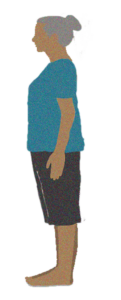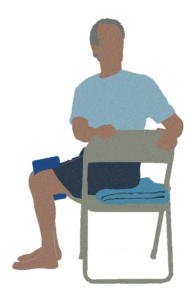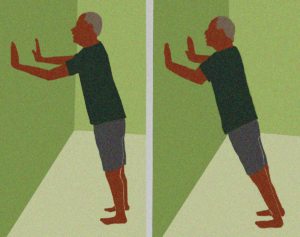 If you are an older individual, perhaps you are hesitant to try yoga due to certain physical limitations, such as balance issues, chronic pain, joint or back problems, or prolonged physical inactivity. However, the beauty of yoga is that many poses can be easily modified to accommodate physical limitations and varying levels of fitness. Here, we present five classic yoga poses that have been modified for seniors or any individual who is looking for a safe, low-impact form of exercise that can increase overall health and mental well-being.
If you are an older individual, perhaps you are hesitant to try yoga due to certain physical limitations, such as balance issues, chronic pain, joint or back problems, or prolonged physical inactivity. However, the beauty of yoga is that many poses can be easily modified to accommodate physical limitations and varying levels of fitness. Here, we present five classic yoga poses that have been modified for seniors or any individual who is looking for a safe, low-impact form of exercise that can increase overall health and mental well-being.

Mountain pose (Tadasana)
Helps with posture and balance
Stand tall with big toes touching, heels together, abdominal muscles drawn in, arms hanging loose by your sides, eyes looking forward, leg muscles engaged. Focus on distributing your weight evenly in both feet. Relax your shoulders and back. Hold this pose for 5 to 8 slow breaths in and out.
 Standing forward bend (Uttanasana)
Standing forward bend (Uttanasana)
Stretches hamstrings and back (If you have sciatica or a lower back injury, do not practice this pose.)
Standing with back straight, position your feet slightly apart. Slowly bend over at the hips, letting your torso, arms, neck, and head hang down in a relaxed manner, keeping knees soft (not locked).
For those with vertigo or balance issues, use a chair for support, placing your palms on the seat in front of you as you bend forward. Keep your arms as relaxed as possible, as well as your head and neck. Your head can either face your legs or face the floor, whatever feels the most relaxed and comfortable. Take several slow, deep breaths and focus on the stretch along the back of your body. After a minute or two, slowly stand back up, with feet still slightly apart. Continue using the chair for support if you have vertigo or balance issues.

Half moon pose (standing) (modified Ardha Chandrasana)
Improves balance by stretching and strengthening the core
Standing, with back straight, abdominals engaged, and feet slightly apart, place your left hand on your waist and raise your right arm, fingers to the sky. Slowly breathe in, and, while exhaling slowly, side-bend to the right, feeling the stretching along the right side of your body. Slowly breathe in as you move back into the upright position, and exhale. Lower your right arm, place your right hand on your hip, and lift your left arm. Inhale slowly and exhale as you side-bend to the left. Repeat at least two more times on each side. For a more gentle stretch, keep both hands on your waist as you bend side to side.
 Spinal twist (seated) (modified Bharadvajasana)
Spinal twist (seated) (modified Bharadvajasana)
Tones and stretches the spinal muscles, relieves stiffness in the neck and shoulders
Using a straight-backed chair, sit sideways, pressing your left hip against the chair back. Keep feet parallel to each other and hip-width apart. Place a block or rolled towel between your legs, if necessary, for added support. Additionally, you can place another folded towel under your tailbone, if that feels more comfortable. On the inhale, lift your torso up through the spine and turn your torso to the left, facing the chair back. Grab hold of the chair back with the right hand as you press the palm of the left hand against the other side. Slowly breath in and out for 4 to 6 breaths, holding the stretch. Release and change sides, repeating the stretch to the right, with right hip against chair back.
 Plank pose (wall) (modified Phalakasana)
Plank pose (wall) (modified Phalakasana)
Strengthens arms and shoulders
Stand, facing a wall, and place hands, palms flat and slightly below shoulder height on the wall. Pull your abdominal muscles in, keep your ears over shoulders, and maintain a long neutral neck. Slowly inhale, then, as you exhale, slowly bend arms at the elbow, moving your body toward the wall, as if doing a push-up. As you inhale, push your body back from the wall, keeping palms flat and in contact with the wall at all times. Exhale. Repeat 4 to 6 times.
Editor’s note: Yoga is generally considered a safe form of physical activity for healthy people when performed properly, under the guidance of a qualified instructor. However, as with other forms of physical activity, injuries can occur. Pregnant women, older adults, and people with health conditions should talk to their healthcare provider about their individual needs. They may need to avoid or modify some yoga poses and practices.1
SOURCES
1. National Center for Complementary and Integrative Health. National Institutes of Health. US Department of Health and Human Services. Yoga: what you need to know. Last Updated: May 2019. https://www.nccih.nih.gov/health/yoga-what-you-need-to-know. 5 Feb 2021.
2. Long J. Yoga for seniors: a sequence to help with your mobility. 26 Aug 2019. https://www.yogajournal.com/practice/yoga-for-seniors-sequence-to-help-with-mobility/. 5 Feb 2021.
3. Tweed K. Yoga poses that age well. WebMD site. https://www.webmd.com/healthy-aging/features/yoga-for-seniors#1. 5 Feb 2021.




